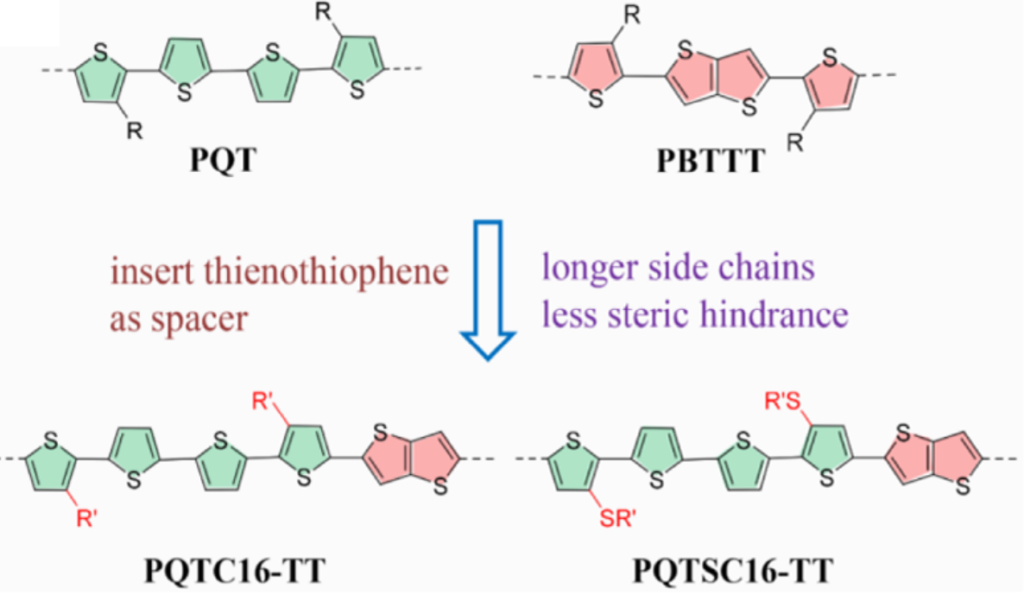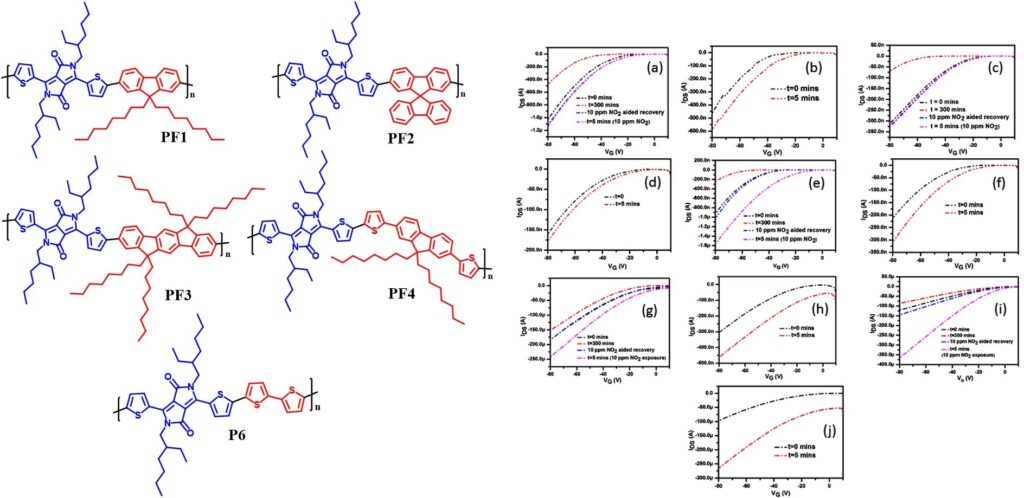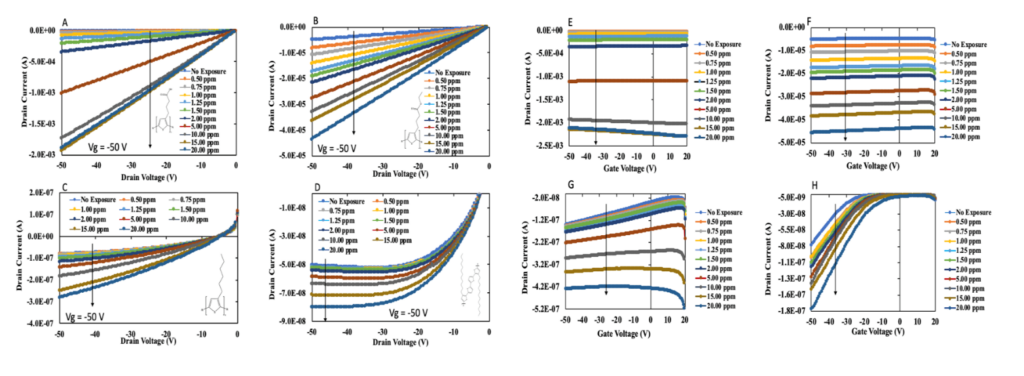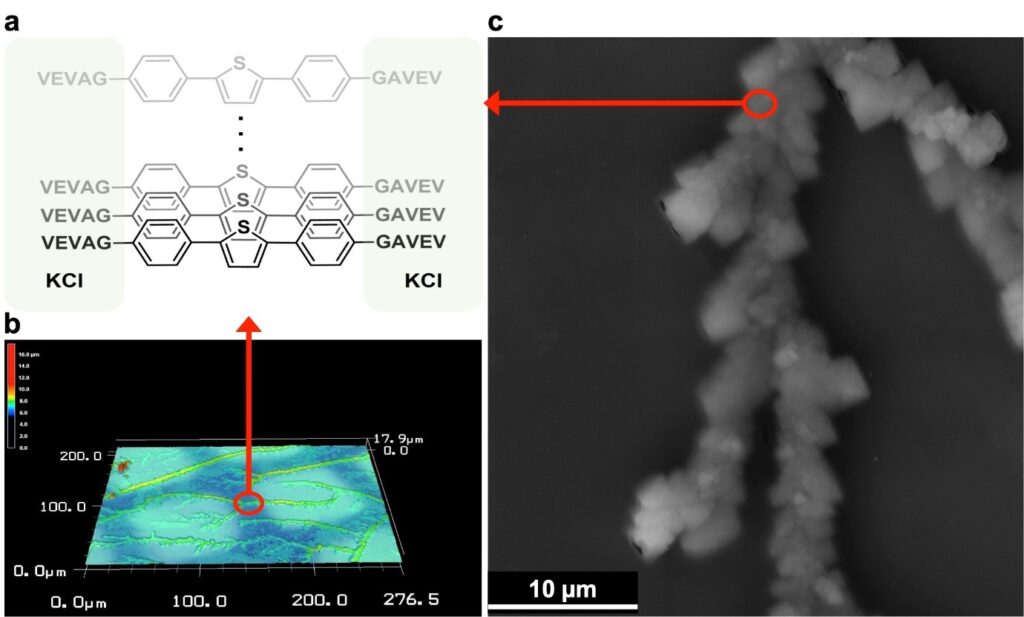Synthesis of Conjugated Polymers as Semiconductors
After many years working in the general organic electronics field, including synthesizing many molecular solid compounds for use in organic field-effect transistors, the synthesis focus in the Katz group has moved to conjugated and elf-assembled polymers based on aromatic, heteroaromatic, and condensed rings. Large values of p-type and n-type conductivity have been demonstrated with unusual environmental stability. Polymers are mixed with specifically matched dopants to increase conductivity and probe doping mechanisms, are characterized in field-effect transistor structures to separate mobility from charge density effects, and implemented for chemical sensing, charge storage, and energy conversion application as described below.

Han, J.; Ganley, C.; Hu, Q.; Zhao, X.; Clancy, P.; Russell, T.P.; Katz, H.E.
“Using pre-formed Meisenheimer complexes as dopants for n-type organic thermoelectrics with high Seebeck coefficients and power factors”
Advanced Functional Materials
2021

Li, H.; DeCoster, M.E.; Ming, C.; Wang, M.; Chen, Y.; Hopkins, P.E.; Chen, L.; Katz, H.E.
“Enhanced Molecular Doping for High Conductivity in Polymers with Volume Freed for Dopants”
Macromolecules 52 9804-9812 10.1021/acs.macromol.9b02048
2019
Chemically Sensitive Devices and Systems
Conjugated polymers interact in different ways with small molecules and biomacromolecules. The binding of different molecules to electronic polymer surfaces changes the charge distribution and local electric fields around them. This is observable as changes in electrical conductivity and/or the voltage at which a gate electrode can induce higher conductivity in a transistor. Selectivity in these responses for specific analyte chemicals leads to chemical sensing. We have recently focused on detection of pollutant gases such as nitrogen dioxide, ammonia, and organic solvent vapors in the environment. Biomacromolecules investigated include glial fibrillar acidic protein (GFAP) and myelin basic protein (MBP), which are biomarkers of brain and neurological injury, and antibodies to them. New electrochemical methods are used to determine the mechanisms of the responses, and simulations guide the design of sensing circuits based on sensitive transistors.

Mukhopadhyaya, T.; Katz, H.E.
“Trap-Dominated Nitrogen Dioxide and Ammonia Responses of Air-Stable p-channel Conjugated Polymers from Detailed Bias Stress Analysis”
J. Mater. Chem. C DOI: 10.1039/D0TC05458E
2021
Jang, H.-J.; Song, Y.; Wagner, J.; Katz, H.E.
“Suppression of ionic doping by molecular dopants in conjugated polymers for improving specificity and sensitivity in biosensing applications”
ACS Applied Materials and Interfaces http://dx.doi.org/10.1021/acsami.0c11125
2020
Wondmagegn, W.; Chu, Y.; Li, H.; Katz, H.E.; Huang, J.
“Simulation of Two-Transistor Parallel and Series Circuits for Gas Sensing Validated by Experimental Data” Journal of Computational Electronics 10.1007/s10825-020-01591-6
2020
Jang, H.-J.; Wagner, J.; Song, Y; Lee, T.; Katz, H.E.
“Carboxylic Acid-Functionalized Conjugated Polymer Promoting Diminished Electronic Drift and Amplified Proton Sensitivity of Remote Gates Compared to Nonpolar Surfaces in Aqueous Media”
Advanced Electronic Materials 10.1002/aelm.201901073
2020
Mukhopadhyaya, T.; Wagner, J.; Han, J.; Katz, H.E.
“Design and Synthesis of Air-Stable p-channel Conjugated Polymers for High Signal-to-Drift Nitrogen Dioxide and Ammonia Sensing”
ACS Applied Materials and Interfaces 10.1021/acsami.0c04810
2020

Wagner, J.S.; Jang, H.-J.; Han, J.; Katz, H.E.
“Enhanced and Unconventional Responses in Chemiresistive Sensing Devices for Nitrogen Dioxide and Ammonia from Carboxylated Alkylthiophene Polymers”
Materials Horizons 7 1358-1371 DOI: 10.1039/D0MH00049C
2020
Fan, H.; Li, H.; Han, J.; McKeever, N.; Yu, J.; Katz, H.E.
“A humid-air-operable, NO2-responsive polymer transistor series circuit with improved signal-to-drift ratio based on polymer semiconductor oxidation”
ACS Sensors 10.1021/acssensors.9b01751
2019
Chu, Y.; Li, H.; Huang, J; Katz, H.E.
“High signal-to-noise chemical sensors based on compensated organic transistor circuits“
Adv. Mater. Tech. https://doi.org/10.1002/admt.201900410 Article number 1900410
2019
Jang, H.; Wagner, J.; Li, H.; Zhang, Q.; Mukhopadhyaya, T.; Katz, H.E.
“Analytical Platform to Characterize Dopant Solution Concentrations, Charge Carrier Densities in Films and Interfaces, and Physical Diffusion in Polymers Utilizing Remote Field-Effect Transistors” Journal of the American Chemical Society 141 4861-4869 10.1021/jacs.8b13026
2019
Li, H.; Shi, W; Song, J.; Jang, H.-J.; Dailey, J.; Yu, J.; Katz, H.E.
“Chemical and Biomolecule Sensing with Organic Field-effect Transistors”
Chemical Reviews 119 3-35 10.1021/acs.chemrev.8b00016 (invited)
2019
Dielectric and Charge-Storing Properties of Materials
There are many situations where an insulating polymer, often designated a “dielectric”, plays an active role in an electronic technology. Besides shielding conductors from each other, they transmit polarizing signals to semiconductor surfaces, adjust the voltage ranges in which semiconducting devices operate, protect devices against very high electric fields, and transduce mechanical into electrical energy, depending on their structure and processing. We design and synthesize polymer heterostructures with defined charge-storage capabilities and impose electric fields on polymer dielectrics adjacent to organic and semiconducting polymers to maximize the efficiency at which the polymers perform logic operations and detect vapors. The fundamental characterization of the heterostructures will be relevant to understanding processes in optoelectronic devices as well.
Plunkett, E; Kale, T.S.; Zhang, Q.; Katz, H.E.; Reich, D.H.
“Effects of trifluoromethyl substituents on interfacial and bulk polarization of polystyrene gate dielectrics”
Applied Physics Letters 114 023301 https://doi.org/10.1063/1.5080951
2019


Zhang, Q.; Kale, T.; Plunkett, E.; Shi, W.; Kirby, B.K.; Reich, D.H.; Katz, H.E.
“Highly Contrasting Static Charging and Bias Stress Effects in Pentacene Transistors with Polystyrene Heterostructures Incorporating Oxidizable N,N’-bis(4-Methoxyphenyl)aniline Side Chains as Gate Dielectrics”
Macromolecules 51 6011-6020 10.1021/acs.macromol.8b00596
2018
Thermoelectric Conversion and Mechanisms in Organic and Polymeric Materials
There is growing interest in using polymer based thermoelectric materials to convert otherwise unused heat to electricity where mechanical flexibility and conformability are also required, such as on the body and on rounded mechanical parts. Using these polymers as the basis of composites with inorganic thermoelectrics would provide advantages arising from the generally higher efficiencies of inorganics along with the processing and mechanical attributes of the polymers. Finally, thermoelectric characterization is a powerful tool for understanding the energy levels at which electronic charges are localized and transported in semiconductors, including conjugated polymers.

Zhang, Q.; Barrett, B.; Bragg, A.E.; Katz, H.E. “Static Polystyrene Gate Charge-Density Modulation of Dinaphthothienothiophene with Tetrafluorotetracyano quino dimethane Layer Doping: Evidence from Conductivity and Seebeck Coefficient Measurements and Correlations”
ACS Applied Electronic Materials 1 2708-2715 10.1021/acsaelm.9b00747
2019
Huang, J. Li; H., Kirksey, E.; Hoffman, C.; Jang, H.-J.; Justine Wagner, J.; Madan, D.; Katz, H.E.
“Contributions to Composite Conductivity and Seebeck Coefficient in Commercial Bi2Te3 – Conjugated Polymer Composites”
Journal of Applied Physics 125 125502 DOI: 10.1063/1.5089872
2019

Li, H.; Plunkett, E.; Cai, Z.; Qiu, B.; Wei, T.; Chen, H.; Thon, S.M.; Reich, D.H.; Chen, L.; Katz; H.E.
“Dopant-Dependent Increase in Seebeck Coefficient and Electrical Conductivity in Blended Polymers with Offset Carrier Energies”
Advanced Electronic Materials 5 1800618 https://doi.org/10.1002/aelm.201800618
2019
Hybrid Nanostructures from Conjugated Cores and Polypeptides
Conjugated molecules and polymers are often organized with aromatic rings stacked so that energy and charge transport among molecules is promoted. Polypeptides have their own systems of self-organization as has been evolved through biology, with hydrogen bond networks enforcing preferred arrangements. The synergistic combination of the two kinds of molecular organization, pioneered by Professor J.D. Tovar of the JHU Department of Chemistry, leads to elongated and stable nanostructures in which optical and electronic communication can occur. We are probing mechanisms by which these nanostructures grow with the best structural specificity, and the ways in which electrical conductivity can be induced in these nanostructures, guided by computational studies of molecular conformations and intermolecular interactions. We recently discovered an inorganic crystallization templating effect as an additional function of these nanostructures.

Lee, T.; Panda, S.; Tovar, J.D.; Katz, H.E.
“Unusually Conductive Organic-Inorganic Hybrid Nanostructures Derived from Bio-Inspired Mineralization of Peptide/Pi-Electron Assemblies”
ACS Nano 14 1846-1855 DOI 10.1021/acsnano.9b07911
2020
Panda, S.; Katz, H.E.; Tovar, J.D.
Solid-state electrical applications of protein and peptide based nanomaterials”
Chemical Society Reviews 47, 3640-3658
2018